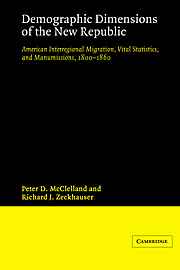 Demographic Dimensions of the New Republic
Demographic Dimensions of the New Republic Published online by Cambridge University Press: 19 September 2009
The substantive conclusions of this study have been summarized in chapter 1. The central methodological point deserves further scrutiny because it has been so frequently ignored.
The point concerns the linkage between data accuracy and hypothesis testing. The pioneering work of Conrad and Meyer illustrates the problem. Their primary objective was to measure the profitability of slavery. This required comparing the rate of return from owning slaves with the return available on investment alternatives. Finding the average rate of return for slave owning to range from 4½ to 8 percent and that available on alternative investments to vary between 6 and 8 percent (101), the authors concluded that ‘Slavery was profitable to the whole South.’ (121)
One of several numerical inputs needed to calculate the rate of return from owning slaves is the value of land required per field hand, a number that bulks large in the final calculation. This was apparently derived by Conrad and Meyer from two sources: (a) Lewis Gray's estimate of $35 per acre for a large plantation devoted to upland cotton ‘say, in the Mississippi alluvium’ and (b) the report of a single farmer in Barbour County, Alabama, to The Southern Cultivator in 1846 concerning his operating costs during the previous two years, the relevant entry reading, ‘Say, 360 acres poor pine land at $6 per acre.’
To save this book to your Kindle, first ensure [email protected] is added to your Approved Personal Document E-mail List under your Personal Document Settings on the Manage Your Content and Devices page of your Amazon account. Then enter the ‘name’ part of your Kindle email address below. Find out more about saving to your Kindle.
Note you can select to save to either the @free.kindle.com or @kindle.com variations. ‘@free.kindle.com’ emails are free but can only be saved to your device when it is connected to wi-fi. ‘@kindle.com’ emails can be delivered even when you are not connected to wi-fi, but note that service fees apply.
Find out more about the Kindle Personal Document Service.
To save content items to your account, please confirm that you agree to abide by our usage policies. If this is the first time you use this feature, you will be asked to authorise Cambridge Core to connect with your account. Find out more about saving content to Dropbox.
To save content items to your account, please confirm that you agree to abide by our usage policies. If this is the first time you use this feature, you will be asked to authorise Cambridge Core to connect with your account. Find out more about saving content to Google Drive.